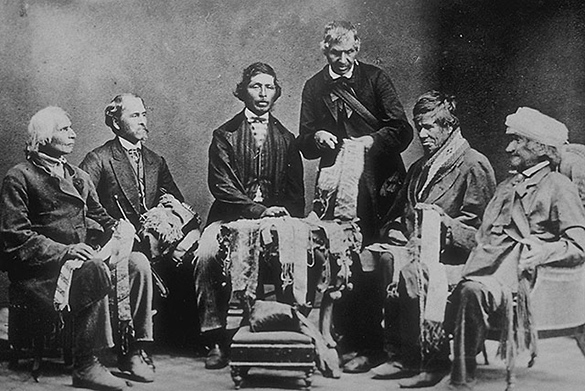Minds On
Agreements to share land
“Before Canada was a country, treaties dominated the landscape. Between Anishinaabeg and Haudenosaunee, or Nêhiyaw and Dakota, or Muskego and Inuit, formal arrangements to share the land and undertake peaceful relations were common. We have stories of the very first treaties — treaties with the land itself (with the bear, the deer, the waters and so on) — that stretch back thousands of years.”
Source: Hayden King, 2016: “Anatomy of a First Nations Treaty,” https://www.tvo.org/article/anatomy-of-a-first-nations-treaty
In this learning activity, you will explore a few key treaties of relevance during this period and explain the significance of these agreements to various people in Canada.

Explore the following Heritage Minutes video entitled “Naskoomitowin” to learn more about Treaty 9.
After exploring the video, complete the chart outlining what you might already know about treaties and their effects on Indigenous Peoples in Canada and what you wonder about treaties in Canada.
Complete the What I Know About Treaties in your notebook or using the following fillable and printable document or in a method of your choice.
| What I know | What I wonder |
|---|---|
Press the ‘Activity’ button to access What I Know About Treaties.
Action
Task 1: Treaty exploration
It is important to note that during this time period Canada was called British North America. When colonizers arrived in Canada, they were greeted by treaty-makers.
Press ‘Colonizers’ to reveal a definition of the term.
Colonizers: people who came to Canada in an attempt to establish political control.
Much of Canada’s land mass is covered by treaties. A treaty is a binding agreement made between two parties. For Indigenous peoples, the sacred and binding characteristics of a treaty are not found in the legalistic language but rather the oral agreement. To Indigenous peoples, treaties are more than mere documents or transactions, but a practice and a custom that endure over time. For Indigenous communities, treaty deliberations were often accompanied by ceremonial components, such as smoking pipes or the exchange of a symbolic present. Treaties made between Indigenous people and the government typically concern land. Indigenous people were asked to share their land in exchange for payments and/or other promises.
In this task, you will be independently exploring two different treaties that were established between 1713 and 1800. Choose two from the following list of the treaties and conduct research to complete the graphic organizer. Begin your research by exploring Indigenous websites, government websites, and encyclopedias. Record your findings in the organizer provided or in a method of your choice. Use the interactive checklist as you are researching and when you are finished to make sure your organizer is complete.
- Treaty of Portsmouth
- Peace and Friendship Treaties
- Treaty of Niagara
- British-Inuit Peace Treaty
- Treaty of Paris
- Covenant Chain
Complete the Treaty Research Organizer in your notebook or using the following fillable and printable document or in a method of your choice..
|
Treaty name and year: |
||
|
Involved parties: |
||
|
Key points: |
||
|
Land rights: |
||
|
Short- and long-term consequences: |
Press the ‘Activity’ button to access Treaty Research Organizer.
Press the following tabs to reveal questions that will guide your research.
Treaty Research Checklist
Task 2: Wampum belts
Wampum belts are a vital part of the Onondaga and Haudenosaunee culture. The belts are thought of as a living record and history of the Haudenosaunee. When a string of a wampum belt is held in a person’s hand, they are said to be speaking truthfully and others are listening attentively and respectfully to the speaker.

A photograph of 6 Iroquois chiefs examining wampum belts in the nineteenth century.
Source: People of the Hills, Onondaga Nation. “Wampum.” Onondaga Nation, 27 Jan. 2021, www.onondaganation.org/culture/wampum/.
Investigate the video entitled “The Mystery of the Big Deal” with Darren and E.B. to learn more about wampum belts.
Knowledge check
Test what you know! Select the correct answer to the following questions about wampum belts based on the video.
Connections
Reflect
Based on what you’ve learned, explain what a wampum belt is. Why is it so important to First Nations peoples and colonizers?
Press ‘Hint’ to reveal information that will guide your thinking.
Consolidation
Comparing perspectives
In this learning activity, you have explored treaties that were established between various groups and First Nations, Métis, and Inuit communities in Canada. You have also explored the wampum belt and its importance to Indigenous Peoples, as well as modern-day treaties in Canada.
Reflect on what you’ve learned and answer the following prompts in a method of your choice. Use evidence from your learning to support your responses.
Prompt 1
How did the perspective of Indigenous communities (First Nations, Métis, and Inuit) differ from that of European colonizers in respect to treaties? How were they viewed by each group? What were the advantages and disadvantages of treaties for both groups?

Prompt 2
What were the short- and long-term consequences of treaties in Canada in the 18th century? How did they affect Indigenous communities then? How do they still affect Indigenous communities today?

Inspired by the multi-family longhouses found in historical Huron-Wendat villages, ideally located near land suitable for farming and close to water access.
Reflection
As you read the following descriptions, select the one that best describes your current understanding of the learning in this activity. Press the corresponding button once you have made your choice.
I feel...
Now, expand on your ideas by recording your thoughts using a voice recorder, speech-to-text, or writing tool.
When you review your notes on this learning activity later, reflect on whether you would select a different description based on your further review of the material in this learning activity.
Press ‘Discover More’ to extend your skills.
Discover MoreChoose one activity
- Examine maps of Canada before and after the Treaty of Paris. What do you notice about the changes in settlement trends?
- Investigate the treaty-making process and how it has changed from the 1700s to modern-day Canada.
- Examine the Covenant Chain Wampum of 1764. Which questions can you formulate to guide your investigation into different perspectives of this treaty agreement?
- Explore the following article entitled "Who Has the Right to Ontario’s Algonquin Lands?" on modern day treaties. How are Indigenous communities still affected by land claims?
Press tvo today to access "Who Has the Right to Ontario’s Algonquin Lands?"
(Opens in a new tab)